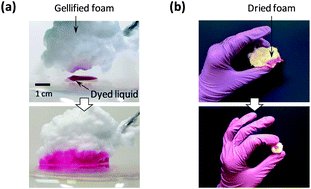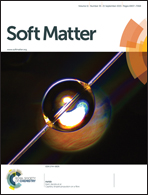Time scales for drainage and imbibition in gellified foams: application to decontamination processes†
Abstract
We probe the drainage and imbibition dynamics of foams in which the continuous aqueous phase is a transient gel-like network. To produce these foams, we provide a new method – a PVA (polyvinyl alcohol) solution is first foamed and then a cross-linker, Borax, is added, which binds reversibly to the PVA chains. The resulting foams are ultra-stable-over a month. We find that the typical time for gravitational drainage of the continuous phase can be slowed down from hours to several weeks by tuning the Borax concentration. We show that the Borax concentration controls both the bulk viscosity of the continuous phase and the surface viscosity of the air–water interfaces. From these results we suggest that the PVA molecules adsorbed at the bubble interfaces are highly cross-linked by the Borax molecules. We find that the capillary rise of a dyed liquid into these foams is orders of magnitude faster than the drainage flow, meaning that these foams can quickly absorb liquids. These results show that these foams could be used to clean or decontaminate surfaces covered with liquid wastes. Indeed we show that the PVA–Borax foam can easily be spread on a surface, absorb a liquid without destabilizing and be dried afterward to recover the waste.


 Please wait while we load your content...
Please wait while we load your content...